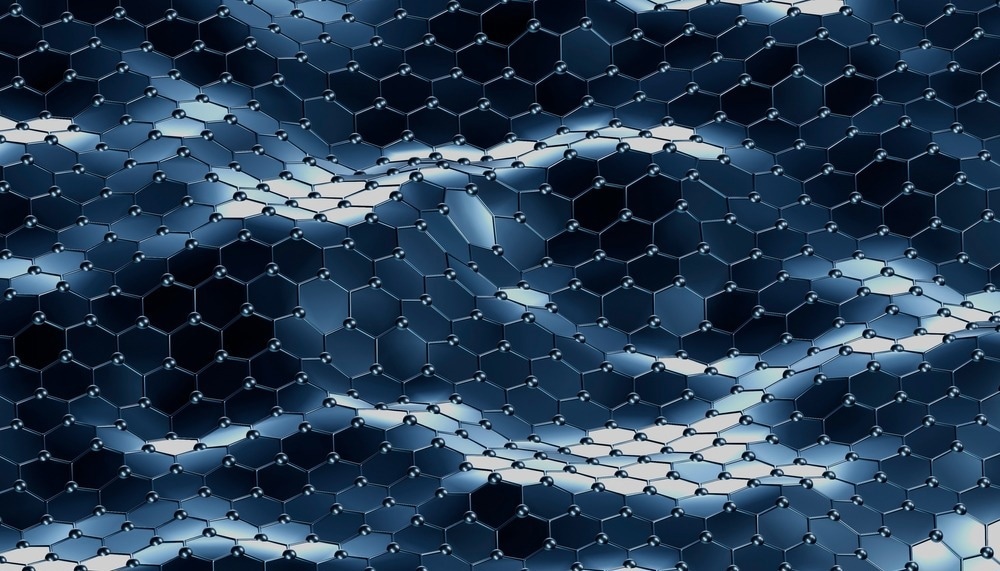Writing in Ceramics International, a team of researchers from the University of Wollongong in Australia and Zhengzhou University in China has presented a study on the influence of graphene nanoplatelets on geopolymer composites.

Study: Mechanical properties of engineered geopolymer composite with graphene nanoplatelet. Image Credit: Icruci/Shutterstock.com
Geopolymers
Geopolymers use industrial waste materials as cementitious components. These innovative construction materials are more sustainable than conventional mortar and concrete, with fewer carbon emissions and the key benefit of utilizing critical waste streams which would otherwise be disposed of in the environment.
Geopolymers possess superior engineering properties, such as corrosion resistance, chemical stability, good strength gain, and low shrinkage rate. However, concrete and mortar made out of geopolymers can suffer from ductility and brittleness issues compared to conventional concrete and mortar using materials such as ordinary Portland cement.
Due to these issues, geopolymer concretes are prone to critical failures like cracking under mechanical stress. This significantly impacts the serviceable life of structures constructed out of geopolymer composites, with negative effects on safety and cost for building projects. Serious deterioration of geopolymer concretes can occur in a relatively brief period of time compared to ordinary Portland cement concrete.
Incorporating Fibers into Geopolymers
Research has focused on strategies to improve the mechanical properties of geopolymer concretes and reduce the formation of cracks that limit the material’s commercial application.
Incorporating fibers into the matrices of geopolymers to form composite materials is beneficial for the design of geopolymer concretes with satisfactory mechanical and physical properties. Fiber bridging action controls the formation and proliferation of cracks within reinforced composites and increases the energy needed for crack propagation.
However, whilst they possess superior fracture toughness, these materials still suffer from quasi-brittleness. This quasi-brittleness is characterized by a strain-softening response within fiber-reinforced geopolymer composites.
Engineered Cementitious Composites
Engineered cementitious composite is a type of fiber-reinforced cementitious composite that possesses a strain hardening response due to its design, which is based on the micromechanical model. This material has excellent ductility. PVA is commonly used in this material due to its beneficial mechanical properties, chemical compatibility with cement, and good water affinity.
Recent studies have demonstrated the superior performance of engineered cementitious composite compared to ordinary Portland cement. Research has shown that this cementitious material has up to one hundred times the tensile strain capacity of conventional concrete.
In recent years, engineered geopolymer composites have been developed to address several current issues with conventional cementitious materials. Industrial waste materials such as slag-fly ash have been evaluated as composite materials to improve the mechanical properties and sustainability of these materials. Studies have demonstrated significant reductions in CO2 emissions and embodied carbon.
The Study
The new paper in Ceramics International has investigated the use of graphene nanoplatelets in engineered geopolymer composites. Previous studies have demonstrated the benefits of using this carbon-based nanomaterial in these innovative construction materials. Graphene nanoplatelets are composed of several layers of graphene.
Recent research has demonstrated that graphene nanoplatelets are less prone to entanglement and agglomeration due to their increased thickness compared to graphene. Properties such as tensile strength and Young’s modulus are significantly improved by the incorporation of these nanomaterials into polymer matrices. However, there are still issues with brittleness in these composites.
The influence of graphene nanoplatelets on the engineered geopolymer composite was thoroughly analyzed and evaluated by the authors. Geopolymers were prepared from PVA fibers and slag-fly ash. A 2% addition of PVA fibers was used, which previous studies have indicated is the optimal proportion to ensure composite performance. Different proportions of graphene nanoplatelets were evaluated.
Analysis of graphene nanoplatelet percentage incorporation demonstrated that the geopolymer composite’s tensile properties increased with up to 0.5% incorporation, reducing beyond this amount. The influence of graphene nanoplatelets upon other mechanical properties such as compressive strength, flexural behavior, and density was unclear.
Several tests were used in the study, including four-point binding, density, uniaxial tension, and compression tests. SEM was employed to analyze the prepared geopolymer composite’s microstructure.
Study Conclusions
Some important conclusions were drawn based on experimental and analytical results. Graphene nanoplatelets reduce geopolymer cement workability but have less effect on density and compressive strength. Tensile strain capacity and tensile strength are improved. Additionally, the results of four-point bending tests demonstrated increased peak load and mid-span deflection. The multiple cracking behavior was also improved.
In addition, SEM microstructural analysis demonstrated that a 0.5% addition of graphene nanoplatelets in the composite causes significant abrasions on the surface of PVA fibers. Superior bond behavior was observed between fibers and the geopolymer matrix. A 0.5% graphene nanoplatelet incorporation enhances the composite’s flexural and tensile behavior but slightly decreases its compressive strength.
More from AZoM: How is 3D Printing Changing the Textile Industry?
Further Reading
Li, Z et al. (2022) Mechanical properties of engineered geopolymer composite with graphene nanoplatelet Ceramics International [online, pre-proof] sciencedirect.com. Available at: https://www.sciencedirect.com/science/article/pii/S0272884222028681
Disclaimer: The views expressed here are those of the author expressed in their private capacity and do not necessarily represent the views of AZoM.com Limited T/A AZoNetwork the owner and operator of this website. This disclaimer forms part of the Terms and conditions of use of this website.